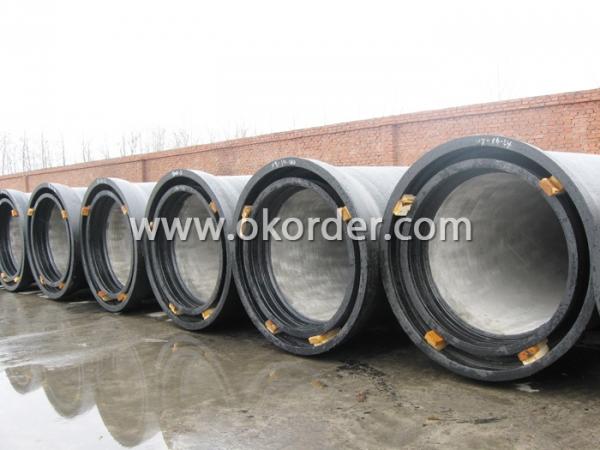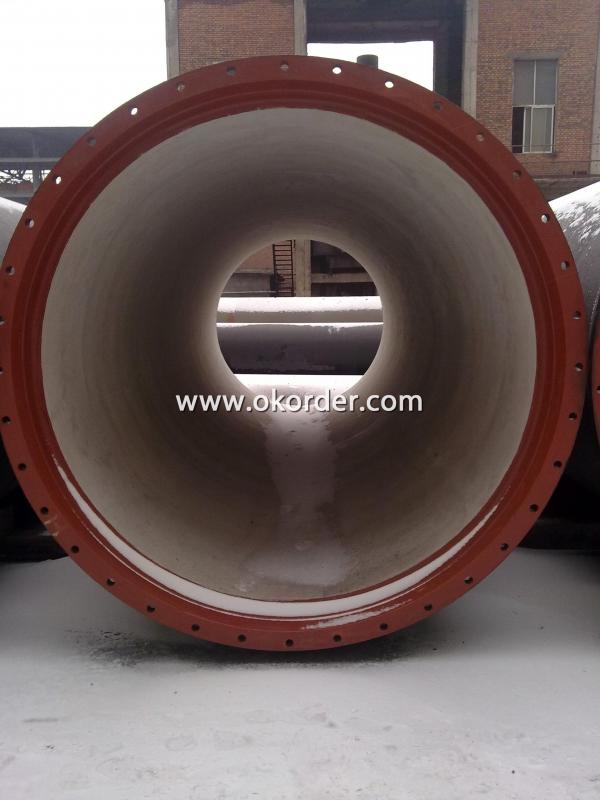Loading Port:China Main Port
Payment Terms:L/C,D/A,D/P,T/T
Min Order Qty:1 Metric Ton m.t.
Supply Capability:300000 Metric Tons per Year m.t./month
General introduction of Mechanical Joint K Type Ductile Iron Pipe
•Material: Ductile Cast Iron
•Size Range: DN 80mm to DN 2000mm
•Unit Effective Length: 5.7m or 6m or negotiable
•Manufacture Standard: ISO 2531:1998/ EN 545:2006/EN 598:2007
•Annual capacity: 300,000 tons
• Internal lining: cement mortar lining comply with ISO4179.
External coating: sprayed metallic Zinc coating (min.130g/m2) according to ISO8179 + bitumen painting (min.70μm) according to BS3416.
Gasket: Matched 100% natural rubber gasket in accordance with ISO4633.
•Special requirements on external coating and internal lining can be applied
•We also provide accessories such as SBR/EPDM rubber gaskets, lubricant paste, pipe caps, PE sleeves, etc.
Features of Ductile Iron Pipes:
Ductile iron pipes is stronger and easier to tap, requires less support and provides greater flow area compared with pipes made from materials like PVC, concrete, polyethylene, or steel.
Application:
Used for water and sewer lines.
Specification of Mechanical Joint K Type Ductile Iron Pipe:
Standard wall thickness of Mechanical Joint K Type Ductile Iron Pipe
|
Nominal Diameter |
Wall Thickness(mm) | ||||||
|
DN(mm) |
Pipe |
Fittings | |||||
|
Class C |
K8 |
K9 |
K10 |
K12 |
K12 |
K14 | |
|
80 |
4.4 |
6 |
6.0 |
7 |
8.1 | ||
|
100 |
4.4 |
6.0 |
7.2 |
8.4 | |||
|
125 |
4.5 |
6.3 |
7.5 |
8.8 | |||
|
150 |
4.5 |
6.3 |
7.8 |
9.1 | |||
|
200 |
4.7 |
6.3 |
8.4 |
9.8 | |||
|
250 |
5.5 |
6.8 |
7.5 |
9 |
9 |
10.5 | |
|
300 |
6.2 |
6.4 |
7.2 |
8 |
9.6 |
9.6 |
11.2 |
|
350 |
6.3 |
6.8 |
7.7 |
8.5 |
10.2 |
10.2 |
11.9 |
|
400 |
6.5 |
7.2 |
8.1 |
9 |
10.8 |
10.8 |
12.6 |
|
450 |
6.9 |
7.6 |
8.6 |
9.5 |
11.4 |
11.4 |
13.3 |
|
500 |
7.5 |
8 |
9 |
10 |
12 |
12 |
14 |
|
600 |
8.7 |
8.8 |
9.9 |
11 |
13.2 |
13.2 |
15.4 |
|
700 |
8.6 |
9.6 |
10.8 |
12 |
14.4 |
14.4 |
16.8 |
|
800 |
9.6 |
10.4 |
11.7 |
13 |
15.6 |
15.6 |
18.2 |
|
900 |
11.6 |
11.2 |
12.6 |
14 |
16.8 |
16.8 |
19.6 |
|
1000 |
12.6 |
12 |
13.5 |
15 |
18 |
18 |
21 |
|
1200 |
13.6 |
13.6 |
15.3 |
17 |
20.4 |
20.4 |
22.8 |
|
1400 |
15.7 |
15.2 |
17.1 |
19 |
22.8 |
22.8 |
26.6 |
|
1500 |
16.7 |
16 |
18 |
20 |
24 |
24 |
31 |
|
1600 |
17.7 |
16.8 |
18.9 |
21 |
25.2 |
25.2 |
29.4 |
|
1800 |
19.7 |
18.4 |
20.7 |
23 |
27.6 |
27.6 |
32.2 |
|
2000 |
21.8 |
20 |
22.5 |
25 |
30 |
30 |
35 |
Mechanical Joint K Type
The mechanical joint is a bolted joint utilizing a ductile iron gland and mechanical joint gasket. The mechanical joint is recommended for water service where many connections are required. All components of the mechanical joint are interchangeable. The spigot end of mechanical joint pipe has the same outside diameter as push-on joint pipe. As a result, it can be fitted into such joints in the field by beveling the outside edge. All of the accessories (glands and fasteners) are supplied with each joint.

Nominal Diameter DN of Mechanical Joint K type Ductile Iron Pipe
|
Nominal Diameter DN |
mm |
Holes No. | |||
|
DE |
D1 |
D |
T | ||
|
100 |
118 |
186 |
232 |
80 |
4 |
|
150 |
170 |
241 |
287 |
80 |
6 |
|
200 |
222 |
292 |
338 |
80 |
6 |
|
250 |
274 |
348 |
394 |
80 |
8 |
|
300 |
326 |
399 |
445 |
110 |
8 |
|
350 |
378 |
458 |
504 |
110 |
10 |
|
400 |
429 |
512 |
558 |
110 |
12 |
|
500 |
532 |
618 |
664 |
110 |
14 |
|
600 |
635 |
725 |
771 |
110 |
14 |
|
700 |
738 |
839 |
893 |
120 |
16 |
|
800 |
842 |
942 |
996 |
120 |
20 |
|
900 |
945 |
1052 |
1118 |
120 |
20 |
|
1000 |
1048 |
1160 |
1226 |
130 |
20 |
|
1200 |
1255 |
1372 |
1438 |
130 |
28 |
|
1400 |
1462 |
1591 |
1657 |
130 |
28 |
|
1600 |
1668 |
1790 |
1856 |
160 |
30 |
|
1800 |
1675 |
1996 |
2062 |
170 |
34 |
|
2000 |
2082 |
2216 |
2282 |
180 |
36 |
Handling and Transportation of Ductile Iron Pipe Mechnical Joint K Type.
Hoisting
Take precaution of handling pipe with steel cable, hoisting belts and specialized rigging avoiding from pipe's rocking. While using steel cable, single cable is not admitted, for the purpose of protecting outer anti-corrosion layer, steel cable should be packed by rubber or other similar material. While using hook, it also should be covered with rubber or other similar material for protecting cement lining layer. Especially for pipe with relative large diameter, hook should be mounted a gasket with same shape as internal diameter of pipes while handling. It is not available fixing hook on the steel belts or socket side and spigot side of pipe while handling pipes in bundle.
Transportation
Put two pieces or more woods on the platform of the vehicle while transporting, pipes are laid on the wood and fixed by wedge. The part over the vehicle body should not be more than 1/4 of overall length of pipe. If pipes are piled up more than one layer, each layer of pipes should reverse, and buffering rubber or gasket should be put on the space between two layers of pipes, at last pipes are fixed up with steel cable and buffering gasket. Check often if pipes can fall out during conveying, and check if stop wedge is not hard up. The vehicle should slow down on the uneven road or while swerving.
Storage
Under pipes there should be put wedge or crosstie while stacking pipes, and socket and spigot of pipes should be interleaved and on the stop wedge in cast of pipe's rolling. Uneven and serious polluted ground, or slope and marshy are not available.
Pictures Show of Mechanical Joint K Type Ductile Iron Pipe


If any questions, please feel free to contact us.